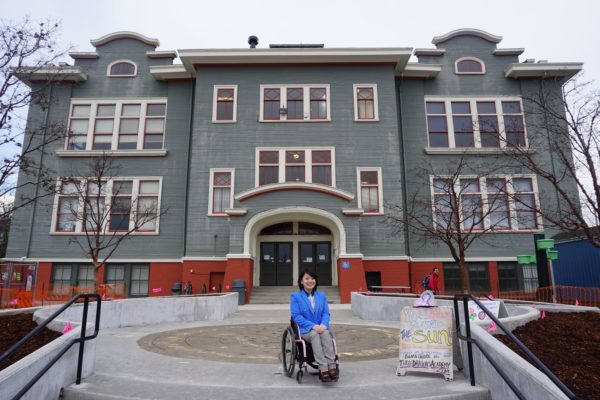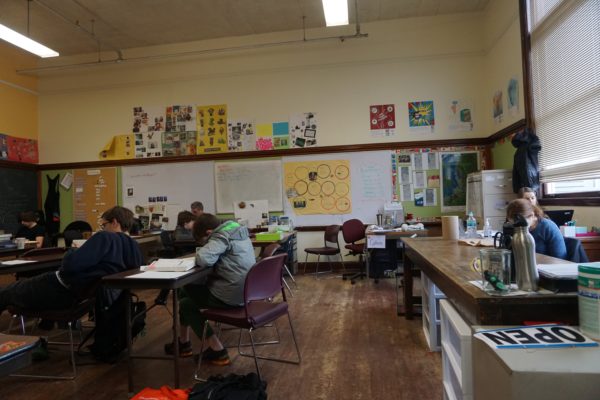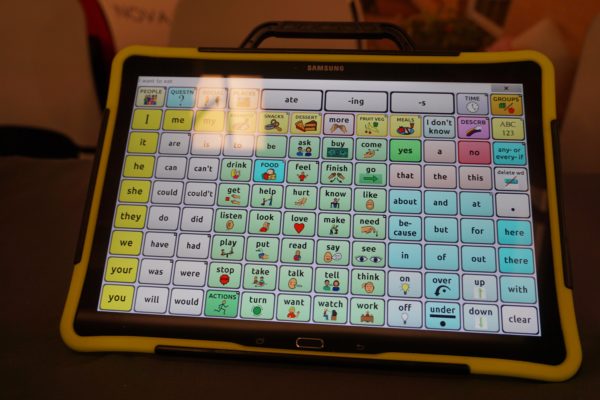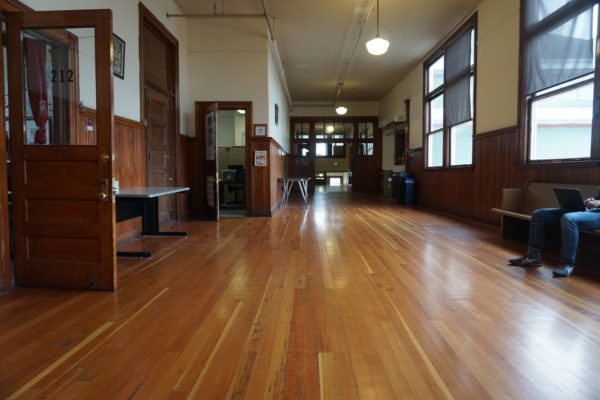This article is also available in: 日本語

It has been 6 months since I moved to the US.
One of the reasons why I feel more comfortable to live here is that people do not stare at me.
Moreover, people are willing to open a door and hold it for me, or let me go first when I get on and off an elevator or bus.
There should be various backgrounds that people in the US behave like this toward me, a person in wheelchair, and I believe that education environment is one of the biggest keys.
Last year I have posted reports of school visit in Syracuse (*1) and shared some differences between American and Japanese education environments.
In Seattle, I have visited a non-profit private school, Academy for Precision Learning(APL).
APL, located in a beautiful wooden building, offers K12 (kindergarten to high school) education and has 109 students in total which include students with disabilities.
The largest number of disability is autism spectrum disorder which accounts two thirds of the total students.
Other diagnostic representations include intellectual disabilities, Learning Disabilities, ADD/ADHD, and Depression.
The specialty of APL is fully inclusive education and individualized curriculum.
In public schools, students with disabilities receive IEP(Individual Education Plan *2)to be accommodated in classroom and receive therapy services from physical therapist or occupational therapist at school.
APL strives to provide a higher level of individualized supports for each student determined by their needs and future goals.
APL assists students in brainstorming and identifying high school and beyond plans by age 14 (public school are required to begin at 16 years old.)
Because of APL’s focus on long-term planning at an early age, students have more time to develop the necessary skills before graduation for them to be successful in taking the next steps reaching their goals after graduation.

In public schools, one teacher could have 30 students in a class.
On the other hand, at APL, the maximum students in class is 25.
Adults can be 8 to 10 people including a main teacher, some co-head teachers, Board Certified Behavior Analyst (BCBA), and staffs in charge of students who need one to one support.
At the time of my visit, APL’s high school class had 25 students in total and 15 classroom staff members.
There are also a few part-time teachers who teach specialized subjects.
Currently, no physical therapist or occupational therapist work at APL.
However, if students at APL requires those services, the therapist is able come to APL and provide services to the students on-site.
When I observed a classroom of high school at APL, I met Emily (allonym) who was studying with her individual aid.
Emily is a nonverbal communicator and uses an iPad like the following picture to express her feelings and needs.

I took the picture at an international conference, “Technology and persons with disabilities” in San Diego last month.
Emily uses exactly the same kind of device for communication.
You can see lots of words on the iPad; subject (I, You, He, She), verbs (go, see, eat), feeling (happy, sad), name of things (food, beverage, place).
Emily points out those words and talks with others.
From a general Japanese education perspective, people might feel
“What is the meaning of people with disabilities study in the same classroom although they cannot study the same subject at the same speed?”
Alicia Schmoker, Personalized Pathways Coordinator, who showed me around APL, explained accordingly.

APL’s curriculum is accessible for all students.
For example, Emily takes a biology class like other students do.
The difference between Emily and other students is what she learns in the biology field, and the curriculum is adapted so that it is meaningful for her.
While other students study the human body, Emily studies how to identify feelings such as hunger and pain with her individual aid.
What APL focuses on is teaching skills that are accessible and meaningful to each student depending on their long-term goals.
For Emily there is a high possibility that she will go on to work after she graduates from high school rather than going to college.
What she needs now is to learn how to identify her feelings, self-advocate, and communicate with her peer and members of her community.
These skills will help Emily be able to go to work, go shopping, ride public transportation, and be ab active member of her community
At APL, students are coming from various backgrounds.
Emily is not an exception.
Many students receive academic accommodations on both classwork and tests.
It is very common that your test format is different from your friends’ who is sitting right next to you because it has been modified to accommodate your individual learning style.
Students at APL understand, accept, and value differences.
They view differences as what makes an individual unique and special.
In the high school every September, students work together to develop the policies and guidelines for school life.
Each student has the opportunity to share their ideas with their peers and teachers to create a collaborative working agreement.
In the Spring, this document is reviewed and the policies and expectations are revised and adjustments are made through student recommendations and feedback.
Through this process, students are given a voice and an opportunity to self-advocate which in turn creates more buy-in and motivation to following and respecting the expectations and rules.
I have found that it is not always meaningful for everyone to learn the same topic in the same approach at the same speed.
To tell the truth, not only students with disabilities, but also students without disabilities have various future plans.
Some people would go to college, and some people would start working after mandate education.
Therefore, the information and skills that students need to have should be different from one another.
APL is a school that focuses on individualized curriculum, so I understand all schools cannot operate like APL.
However, I still would like you to know the impacts and effects of inclusive education.
It is possible for students with severe disabilities to learn in the same classroom with other students.
In fact, it is very beneficial to all students.

Lastly I’m gonna share one episode.
When I walked down a hallway at APL, I encountered a girl aged around 10. She looked at me and said,
Girl: Why are you using that (wheelchair)?
Me: I have a disability. I cannot walk.
Girl: I see. (Look at my foots) Are these heels!?
Me: Yes
Girl: Wow! Cool!
From the conversation with the little girl, I found
“There are people who are different from me-> Ask why they are different -> Understand why they are different -> Accept the difference”
Kids can go through this process very very quickly. Including diversity is not something adults are able to do quickly.
I deeply think so.
There are many people who look and act like they are accepting the differences but unconsciously they still have bias towards diversity and disabilities.
The educational environment influences a lot after students get older.
That is to say, if people grow up among people from different backgrounds, accepting differences become very natural thing.
Even after people get older, they know how to communicate with people from different backgrounds.
In the Japanese educational environment, we should not stick too much to the concept of “being the same”, but we could have some “differences”.
That would make huge impacts for students to be able to value everyone’s difference.
Those students would become adults who really accept diversity and inclusion.
I believe a real key for realizing diversity and inclusion is the change of educational environment.
*1 School visit report in Syracuse No.1
*2 School visit report in Syracuse No.2 including IEP explanation
Education Issues In Japan That I Found From Visiting Elementary School In The U.S.
